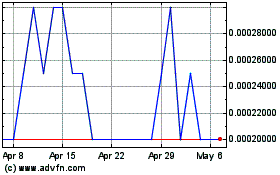SkyFidelity Introduces Mini Cell
Tower Technology.
Newport Beach, CA -- October 26, 2017 -- InvestorsHub
NewsWire -- SkyFidelity. Inc/Tricascade, Inc (OTC Pink: SRMX) In an effort
to improve the delivery of both 4G/5G broadband and CAT-M LTE
technologies to consumers, TriCascade, Inc is in development to
deliver a first of its kind “mini cell tower” called the SkiQ
Tower. The SKiQ Tower will be the first device in the marketplace
to provide an amplification of cellular based technologies in the
4G/5G and CAT-M LTE markets.
In a world where the future of the Internet of Things (IoT)
rests entirely upon reliable cell based frequency delivery, the
SKiQ Tower will be the only device in the marketplace developed
specifically to enhance the signal strength of the major telecom
carriers in the 4G/5G and CAT-M LTE markets. TriCascade contends
that without proper amplification of cell signal frequencies, the
future of IoT Smart Homes will be compromised.
The SKiQ Tower will operate using both the new CAT-M LTE as well
as 5G broadband technology currently under development and ready to
be deployed by all major telecom carriers in 2018.
The SKiQ Tower along with the SKiQ Super Router form the basis
for the IoT Smart Home Hub currently being developed by TriCascade.
With the addition of the Mini Cell Tower technology TriCascade will
be the only technology company in the marketplace to deliver both a
CAT-M LTE and 4G/5G broadband internet connection to consumers
amplified by its proprietary Mini Cell Tower devices.
TriCascade intends to demonstrate the SKiQ Super Router at the
Consumer Electronic Show (CES) in January 2018.
About CAT-M LTE
Verizon announced plans to deploy LTE Category M1 by the end of
the year, claiming it will become the first U.S. operator to launch
the new technology.
Cat M1 is an IoT-centric flavor of LTE that uses 1.4 MHz of
spectrum to deliver 300 kbps to 400 kbps. It appears to resemble a
2G GPRS connection but supports a device battery life of 10 years
or longer, and it is designed to connect sensor applications and
devices requiring lower throughput.
“Up until now, the cost to connect devices to a wide-area
network has been a barrier to widespread IoT," Rosemary
McNally, vice president of mobile devices and operating systems
technology at Verizon, said in a press release. “By evolving our
device ecosystem to include Cat M1, we’re aligning Verizon’s 4G LTE
network to the needs of future IoT deployments. We are also taking
direct aim at emerging low power wireless access (LPWA) solutions,
which have entered the U.S. market, but do not offer the same level
of scale, coverage and security as LTE.”
Verizon touted Cat M1 as “a game-changer for the industry,”
saying supporting chipsets will lower the costs of developing and
deploying IoT devices on a large scale. And that would enable
carriers to better compete with providers of services using
technologies such as Bluetooth, ZigBee and Z-Wave.
The developing LTE technologies will increasingly enable
carriers to compete in the IoT not just against each other but also
against vendors of networks dedicated for IoT use cases. ABI
Research predicted earlier this year that LTE M2M cellular modules
will grow to more than 50 percent of total module shipments by
2021, with much of that growth being driven by businesses and
consumers in North America.
The four major national wireless carriers in the United States
are focusing on 4G LTE (long-term evolution) Category-M (Cat-M) and
narrowband Internet-of-Things (NB-IoT) as their future network
deployment. These are doing so in order to gain maximum benefit
from the lucrative IoT market, per a recent report by
LightReading.
Major U.S. Wireless Carriers
All four major U.S. national wireless carriers are trying hard
to gain maximum profit from the IoT space. Verizon Communications
Inc. VZ has already deployed LTE Cat M and plans to
go ahead with NB-IoT LTE trials in 2018. AT&T Inc. T has also deployed Cat M technology nationwide and
decided to deploy this network in Mexico in 2018. T-Mobile US Inc.
TMUS will start deploying NB-IoT in 2018 together with
Cat-M support. Meanwhile, Sprint Corp. S has announced that it will deploy Cat-M in mid-2018
followed by NB-IoT.
Moreover, in March 2017, satellite TV operator DISH Network
Corp. DISH had announced plans of building a NB-IoT
network to meet the FCC's (Federal Communications Commission)
buildout requirements. Notably, in the last decade, the company has
developed an extremely strong portfolio of lucrative wireless
spectrums which are still unutilized. The company spent nearly $21
billion to build this spectrum portfolio, which, according to some
estimates, is currently valued at no less than $45 billion.
About Tri Cascade, Inc.
Founded in May 2010, Tri Cascade, Inc. is committed to
developing innovative Internet of Things convergent technologies
and products to reduce energy costs and empower the end user for
smarter and safer living. Leveraging its extensive experience in
energy management, wireless networking, and home and B2B automation
and device control systems, Tri Cascade focuses on bringing leading
edge Wi-Fi and machine-to-machine wireless innovations for smart
energy management to both residential and commercial markets. Tri
Cascade aims to use the Internet of Things to make cities dynamic
and responsive to energy demands and sudden energy spikes. Tri
Cascade’s first product release is the i-BRIGHT™7x Smart Surge
Protector, a Wi-Fi-enabled home energy management tool embedded
with online scheduling and power consumption metering on the
Microsoft® Cloud. For more information, visit www.tricascade.com.
Contact:
SkyFidelity, Inc
timothy.peabody@skyfidelityinc.com
7146979748
Saddle Ranch Media (PK) (USOTC:SRMX)
Historical Stock Chart
From Mar 2024 to Apr 2024

Saddle Ranch Media (PK) (USOTC:SRMX)
Historical Stock Chart
From Apr 2023 to Apr 2024
